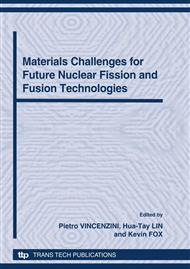p.91
p.97
p.104
p.109
p.118
p.124
p.130
p.136
p.142
Quantitative TEM Investigations on EUROFER 97 Irradiated up to 32 Dpa
Abstract:
The objective of this work is to evaluate the microstructure of the neutron-irradiated reduced activation ferritic/martensitic (RAFM) steel EUROFER 97. For this purpose irradiation induced defects like defect clusters, dislocation loops, voids/bubbles and precipitates are identified by transmission electron microscopy (TEM) and quantified in size and volume density. Emphasis is put on analyzing the influence of the irradiation dose and neutron fluxe on the evolution of size and density of the defects at irradiation temperatures between 300 and 335 °C. A first sample irradiated to a dose of 31.8 dpa was analyzed. The irradiation was carried out in the BOR 60 fast reactor of JSC “SSC RIAR” in Dimitrovgrad, within the framework of the ARBOR-1 irradiation program. To study the dose dependence in a next step the results will be compared to quantitative data on samples irradiated to a dose of 15 dpa. The obtained quantitative data will be used for correlation of the changes in the microstructure to the changes in the mechanical properties and will serve as an input for models describing this correlation.
Info:
Periodical:
Pages:
118-123
Citation:
Online since:
October 2010
Authors:
Keywords:
Price:
Сopyright:
© 2010 Trans Tech Publications Ltd. All Rights Reserved
Share:
Citation:


